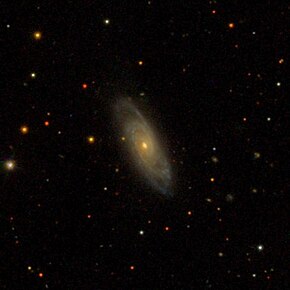NGC 7466
| NGC 7466 | |
|---|---|
 The spiral galaxy NGC 7466 | |
| Observation data (J2000 epoch) | |
| Constellation | Pegasus |
| Right ascension | 23h 02m 03.4738s[1] |
| Declination | +27° 03′ 09.456″[1] |
| Redshift | 0.025044 [1] |
| Heliocentric radial velocity | 7508 ± 3 km/s[1] |
| Distance | 344.4 ± 24.1 Mly (105.60 ± 7.40 Mpc)[1] |
| Apparent magnitude (V) | 13.5[1] |
| Characteristics | |
| Type | Sb[1] |
| Size | ~138,000 ly (42.32 kpc) (estimated)[1] |
| Apparent size (V) | 1.5′ × 0.5′[1] |
| Other designations | |
| IRAS 22596+2647, 2MASX J23020343+2703093, IC 5281, UGC 12319, MCG +04-54-017, Mrk 1127, PGC 70299, CGCG 475-023[1] | |
NGC 7466 is a spiral galaxy in the constellation of Pegasus. Its velocity with respect to the cosmic microwave background is 7160 ± 25 km/s, which corresponds to a Hubble distance of 105.60 ± 7.40 Mpc (∼344 million light-years).[1] It was discovered by French astronomer Édouard Stephan on 20 September 1873.[2] It was independently rediscovered by the French astronomer Guillaume Bigourdan on 19 November 1895 and listed as IC 5281 in the Index Catalogue.[2]
NGC 7466 is listed as a Seyfert II Galaxy, i.e. it has a quasar-like nucleus with very high surface brightnesses whose spectra reveal strong, high-ionisation emission lines, but unlike quasars, the host galaxy is clearly detectable.[1]
NGC 7466 is a galaxy with a nucleus that has excessive amounts of ultraviolet emissions, and is thus listed in the Markarian Galaxy Catalog as Mrk 1127.[1]
One supernova has been observed in NGC 7466: SN 2023uu (type Ia, mag 20.1) was discovered by The Young Supernova Experiment (YSE) on 15 January 2023.[3]
See also
[edit]References
[edit]- ^ a b c d e f g h i j k l m "Results for object NGC 7466". NASA/IPAC Extragalactic Database. NASA and Caltech. Retrieved 7 August 2024.
- ^ a b Seligman, Courtney. "New General Catalogue Objects: NGC 7466". Celestial Atlas. Retrieved 14 December 2024.
- ^ "SN 2023uu". Transient Name Server. IAU. Retrieved 16 December 2024.
External links
[edit] Media related to NGC 7466 at Wikimedia Commons
Media related to NGC 7466 at Wikimedia Commons- NGC 7466 on WikiSky: DSS2, SDSS, GALEX, IRAS, Hydrogen α, X-Ray, Astrophoto, Sky Map, Articles and images
